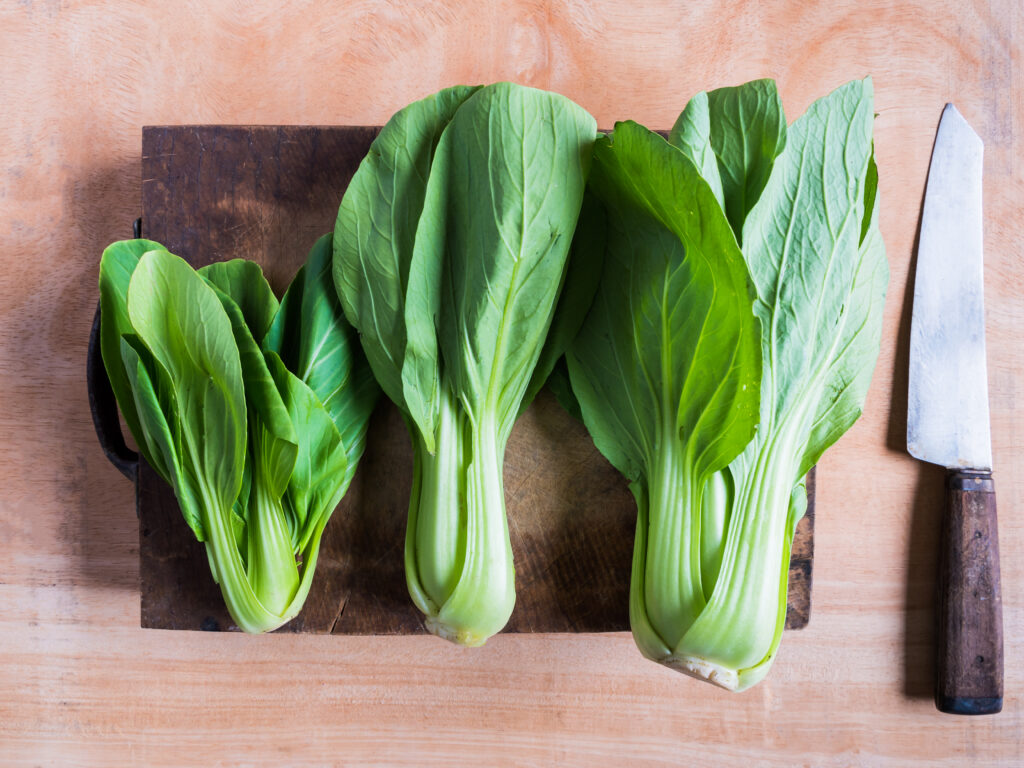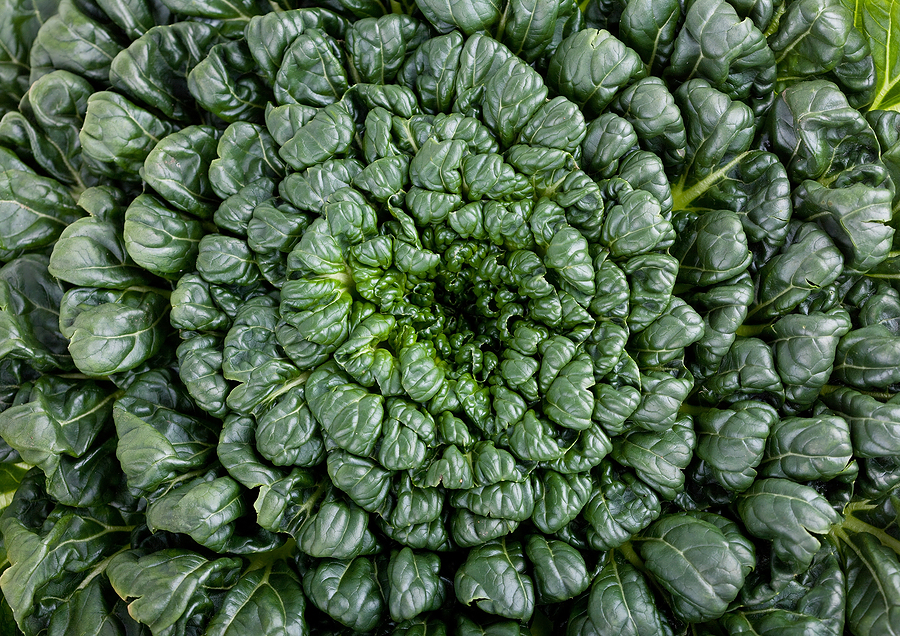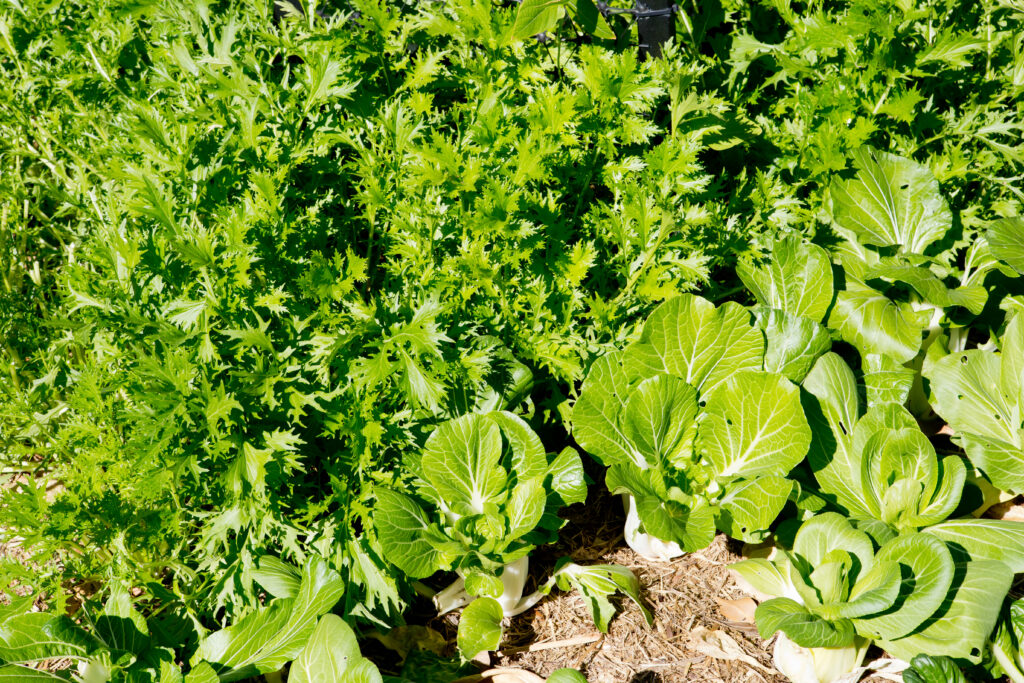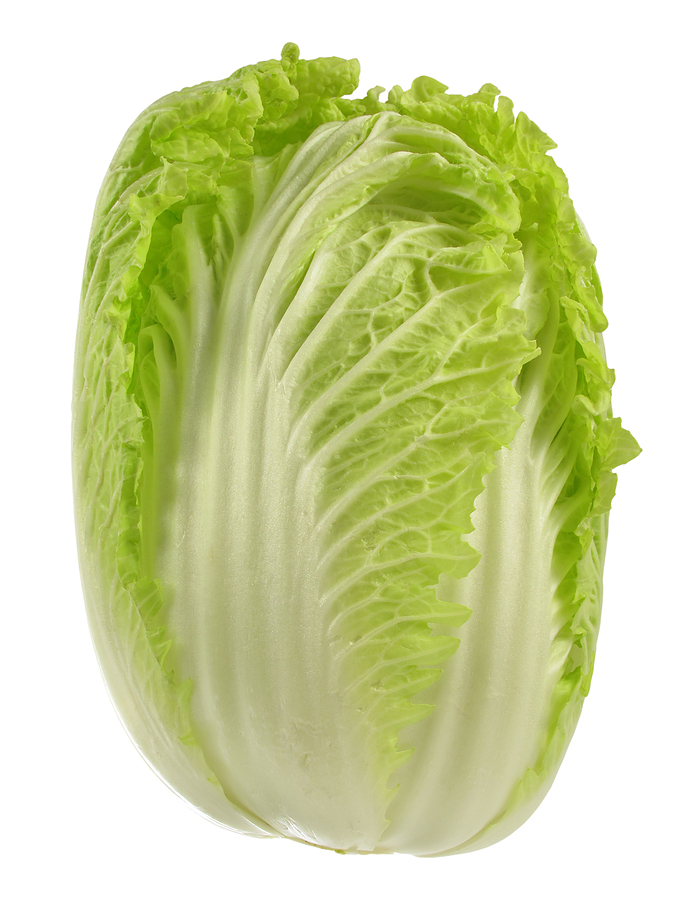Asian greens are a diverse group of leafy vegetables that originate from East and Southeast Asia. Known for their distinct flavors, versatility, and nutritional benefits, these greens are widely used in Asian cuisine, including salads, soups, stir-fries, and pickles. Many Asian greens are also cool-weather crops, making them suitable for fall and spring gardening in temperate climates.
The best way to grow Asian greens is to plant them in well-draining, fertile soil enriched with organic matter, ideally during the cool seasons of spring and fall. Sow seeds directly into the garden or start indoors 4 to 6 weeks before the last frost, planting them 1/4 inch deep. Thin seedlings to allow enough space for growth, usually 6 to 12 inches apart, depending on the variety. Keep the soil consistently moist but not waterlogged, and provide partial shade in hot climates to prevent bolting. Use row covers to protect young plants from pests, and harvest using the “cut and come again” method to encourage continuous growth.
To grow Asian greens in winter, plant them in a sheltered area such as a cold frame, greenhouse, or under row covers to protect them from harsh cold and frost. Choose cold-tolerant varieties like tatsoi, mizuna, and komatsuna, which can withstand low temperatures. Sow the seeds in well-draining soil enriched with compost, spacing them about 6 to12 inches apart, and keep the soil consistently moist. Position the plants to receive as much sunlight as possible, ideally 4 to 6 hours per day. Adding a layer of mulch can help insulate the roots, ensuring the greens continue to grow throughout the winter.
Here is an overview of some popular Asian green varieties and guidelines on how to grow them successfully in a home garden.

Bok Choy (Pak Choi)
Bok choy, also known as pak choi, is one of the most well-known Asian greens. It has dark green, spoon-shaped leaves and thick, white or light green stalks. Bok choy has a mild, cabbage-like flavor with a slightly peppery bite. It comes in several sizes, from baby bok choy, which is tender and suitable for quick cooking, to full-sized heads that can be used in hearty dishes.
- How to Grow Bok Choy: Bok choy prefers cool temperatures and grows best in spring and fall. Plant seeds directly in the garden or start indoors 4 to 6 weeks before the last frost. Sow seeds about 1/4 to 1/2 inch deep in well-draining soil enriched with organic matter. Thin seedlings to 6-12 inches apart, depending on the variety. Water regularly to keep the soil evenly moist, as bok choy can bolt (go to seed) if it experiences drought or extreme temperatures.

Tatsoi
Tatsoi is a low-growing Asian green with dark green, spoon-shaped leaves that form a rosette. It has a mild mustard flavor, similar to spinach but with a bit of pepperiness. Tatsoi is versatile and can be eaten raw in salads or lightly cooked in stir-fries and soups.
- How to Grow Tatsoi: Like other Asian greens, tatsoi thrives in cooler weather and can tolerate light frosts, making it a great fall and early winter crop. Sow seeds directly into the garden or start indoors 4-6 weeks before the last frost date. Plant seeds 1/4 inch deep in fertile soil and thin seedlings to about 6-8 inches apart. Ensure consistent watering, and harvest the outer leaves or entire rosettes as needed.

Mizuna
Mizuna is a Japanese mustard green with finely serrated leaves that resemble frilly lettuce. It has a mild, peppery taste, making it ideal for salads, stir-fries, and soups. The leaves are tender and can be harvested at various stages of growth, from baby leaves to mature plants.
- How to Grow Mizuna: Mizuna is a fast-growing green that does well in cool weather. Sow seeds directly in the garden, 1/4 inch deep, and thin to about 6-12 inches apart once the seedlings have grown. The plant can be harvested as baby greens within 3-4 weeks or allowed to mature. Regular watering and partial shade in hot weather can prevent bolting.
Komatsuna (Japanese Mustard Spinach)
Komatsuna, also known as Japanese mustard spinach, is a hardy green that grows well in various conditions. It has smooth, dark green leaves with a slightly mustard-like flavor, and is a versatile addition to salads, soups, and stir-fries.
- How to Grow Komatsuna: Sow komatsuna seeds in spring or fall for best results. Plant seeds 1/4 inch deep in well-drained soil, spacing the plants about 6-8 inches apart. The greens are fast-growing and can be harvested within 30 days. For a continuous harvest, sow seeds every two weeks. Komatsuna is resistant to bolting and can tolerate both cool and warm temperatures.
Chinese Broccoli (Gai Lan)
Chinese broccoli, also known as gai lan, is a leafy green with thick stems and small florets that resemble those of broccoli. It has a slightly bitter, earthy flavor, and both the leaves and stems are edible. Gai lan is commonly used in stir-fried dishes and is a popular ingredient in Chinese cuisine.
- How to Grow Chinese Broccoli: Chinese broccoli is best grown in cooler temperatures. Plant seeds 1/4 to 1/2 inch deep in rich, well-draining soil. Thin the seedlings to 6-8 inches apart. Gai lan requires consistent watering to keep the soil moist, especially during dry spells. Harvest the leaves, stems, and flower buds when the stems are about the thickness of a pencil.

Napa Cabbage (Chinese Cabbage)
Napa cabbage, also known as Chinese cabbage, is a large-headed cabbage with pale green leaves and thick, white stalks. It has a mild, sweet flavor and is commonly used in salads, stir-fries, and soups. Napa cabbage is also a key ingredient in kimchi, a traditional Korean fermented dish.
- How to Grow Napa Cabbage: Start napa cabbage seeds indoors 4-6 weeks before the last frost or sow directly in the garden in early spring or late summer for a fall harvest. Plant seeds 1/4 inch deep and space the plants 12-18 inches apart. Napa cabbage prefers cool temperatures and moist soil. Mulching helps retain soil moisture and keeps the roots cool, reducing the risk of bolting.

Mustard Greens
Mustard greens are spicy, leafy greens that come in various shapes and colors, including curly, flat, and red-leaved varieties. They have a strong, peppery flavor and can be used raw in salads or cooked to soften the taste. Mustard greens are popular in Southern U.S. cuisine and Asian dishes alike.
- How to Grow Mustard Greens: Plant mustard green seeds 1/4 inch deep in early spring or late summer for a fall crop. Thin the seedlings to 6-12 inches apart. Mustard greens are hardy and can tolerate light frost, which can even enhance their flavor. Regular watering will ensure tender leaves, and frequent harvesting of outer leaves encourages new growth.
General growing tips for Asian Greens
- Soil Preparation: Asian greens prefer well-draining, fertile soil rich in organic matter. Adding compost or well-rotted manure before planting will provide the necessary nutrients for healthy growth.
- Watering: Consistent watering is crucial, especially during dry periods. These greens prefer evenly moist soil, but avoid waterlogging, which can cause root rot.
- Light Requirements: Most Asian greens grow best in full sun to partial shade. In hotter climates, partial shade can help prevent bolting, especially during warm days.
- Pest and Disease Control: Common pests include aphids, flea beetles, and caterpillars. Use floating row covers to protect young plants or apply organic insecticidal soap if needed. Watch for signs of downy mildew or clubroot, particularly in humid conditions.
- Harvesting: Many Asian greens can be harvested using the “cut and come again” method, where outer leaves are picked, allowing the plant to continue growing. Alternatively, the entire plant can be harvested for a larger yield.
Asian greens are a diverse and flavorful addition to any home garden. With varieties ranging from tender, mild greens to robust, peppery leaves, there is an option for every taste and cooking style. By choosing the right time to plant, preparing the soil, and providing adequate care, you can enjoy a bountiful harvest of these nutritious greens throughout the growing season.



